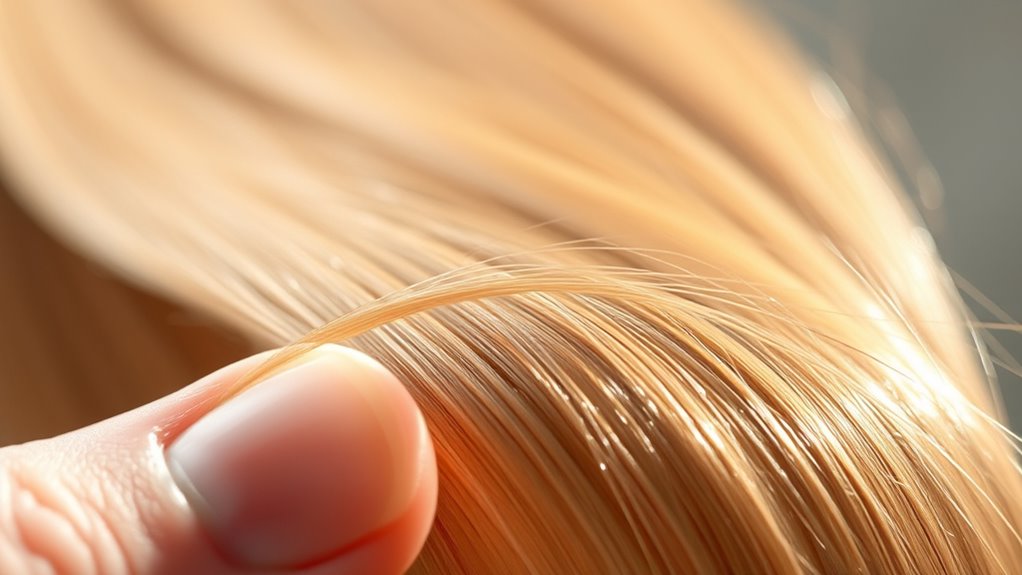To check if your hair is over-processed, perform a simple elasticity test by gently stretching a damp strand between your fingers. If it stretches easily and snaps back, your hair likely maintains good health. However, if it breaks, feels weak, or doesn’t stretch much, it may be damaged from treatments or products. Monitoring these signs can help you identify issues early, and there’s more to uncover about maintaining healthy, resilient hair beyond this quick check.
Key Takeaways
- Conduct a gentle stretch test on damp hair; if it easily stretches and snaps back, elasticity is good.
- If hair breaks or doesn’t stretch much, it may be over-processed or damaged.
- Reduced elasticity indicates potential over-processing, damage, or high porosity levels.
- Regular elasticity testing helps detect early signs of over-processing or structural damage.
- Changes in elasticity patterns can guide adjustments to your hair care routine to prevent further damage.

Have you ever wondered how businesses determine whether their products or services can withstand changes in demand or price? The same principle applies to your hair. When evaluating whether your hair is over-processed, understanding its elasticity becomes essential. Elasticity tests help you gauge how well your hair can stretch and return to its original shape, revealing the health of your strands. Over-processed hair often loses its natural elasticity, making it prone to breakage and damage. But before jumping to conclusions, it’s important to consider factors like hair porosity and scalp health, which greatly influence your hair’s resilience.
Understanding hair elasticity helps identify over-processing and maintain healthy strands.
Hair porosity is a key indicator of how well your hair can absorb and retain moisture. If your strands have high porosity, they tend to absorb products quickly but also lose moisture just as fast, which can weaken the hair shaft over time. Conversely, low porosity hair resists moisture absorption, often leading to dryness and brittleness. Both situations can impact your hair’s elasticity. Over-processing treatments such as bleaching, relaxers, or excessive heat styling can compromise the cuticle, increasing porosity and reducing elasticity. When your hair becomes overly porous, it’s a sign that the structural integrity is compromised, making it less capable of stretching without breaking.
Scalp health also plays a critical role in maintaining healthy elasticity. An unhealthy scalp, plagued with dryness, irritation, or buildup, can hinder your hair’s growth and strength. When your scalp isn’t in good shape, your hair follicles may weaken, resulting in strands that are less elastic and more prone to snapping. To keep your hair’s elasticity intact, you need to nurture your scalp by maintaining proper hygiene, avoiding harsh chemicals, and ensuring it’s well-moisturized. A healthy scalp supports the overall health of your hair, helping it stay resilient through styling and daily wear.
Performing an elasticity test is straightforward. Take a small section of damp hair, gently stretch it between your fingers, and see how far it extends before feeling resistance. If your hair stretches easily and snaps back, it’s a sign of good elasticity. But if it stretches and then breaks or doesn’t stretch much at all, your hair might be over-processed or lacking in moisture and nutrients. Regularly checking your hair’s elasticity can alert you to damage early on, allowing you to adjust your hair care routine accordingly. Additionally, understanding how contrast ratio influences the perception of your hair’s health can motivate you to adopt better care practices.
Frequently Asked Questions
How Often Should I Perform Elasticity Tests at Home?
You should perform elasticity tests at home every few weeks to monitor your hair health. This helps you catch over-processing early and adjust your hair care routine accordingly. Use gentle product recommendations like hydrating conditioners and protein treatments to maintain elasticity. Regular testing ensures your hair stays strong, resilient, and healthy, preventing damage from over-processing. Make it a habit to keep your hair in ideal condition and avoid unnecessary stress.
Can Elasticity Decline Due to Environmental Factors?
Think of your hair as a delicate garden. Humidity impact and pollution effects act like harsh weather, gradually weakening your hair’s elasticity. Excess moisture causes swelling, while pollutants damage the cuticle, making your strands brittle. Over time, these environmental factors diminish your hair’s natural bounce and resilience. Protect your garden by shielding your hair from these elements, maintaining its strength and flexibility despite the ever-changing environment.
What Products Can Help Improve Hair Elasticity?
To improve your hair elasticity, try products focused on hair strengthening and moisture restoration. Look for deep conditioners, leave-in treatments, and serums with ingredients like keratin, biotin, and argan oil. These help rebuild damaged fibers and boost moisture, making your hair more flexible and resilient. Regular use of such products can restore elasticity, reduce breakage, and keep your hair healthy and vibrant over time.
Is Elasticity Testing Suitable for All Hair Types?
Elasticity testing isn’t suitable for all hair types, especially if your hair has high porosity or scalp issues. If your hair tends to absorb moisture quickly or feels fragile, the test could cause damage. Before trying, assess your hair porosity and scalp health. If you have concerns, consult a professional to determine if elasticity testing is safe for your specific hair type.
How Long Does It Take to See Results After Treatments?
You might notice improvements in your hair health within a few days to a week after treatments. Patience is key, as treatment timing varies based on your hair’s condition and the methods used. Keep in mind, gentle care supports your hair’s recovery, and consistent follow-up treatments can enhance results. Remember, good hair health is a journey, and each step brings you closer to your desired look.
Conclusion
Knowing your hair’s elasticity helps prevent over-processing and damage. Did you know that nearly 80% of women experience some form of hair breakage due to over-processed strands? Regular elasticity tests can save you from costly repairs and maintain healthy, resilient hair. So, take a moment to check your hair’s bounce—your strands will thank you for it. Keep a close eye on your elasticity to enjoy beautiful, strong hair every day.









